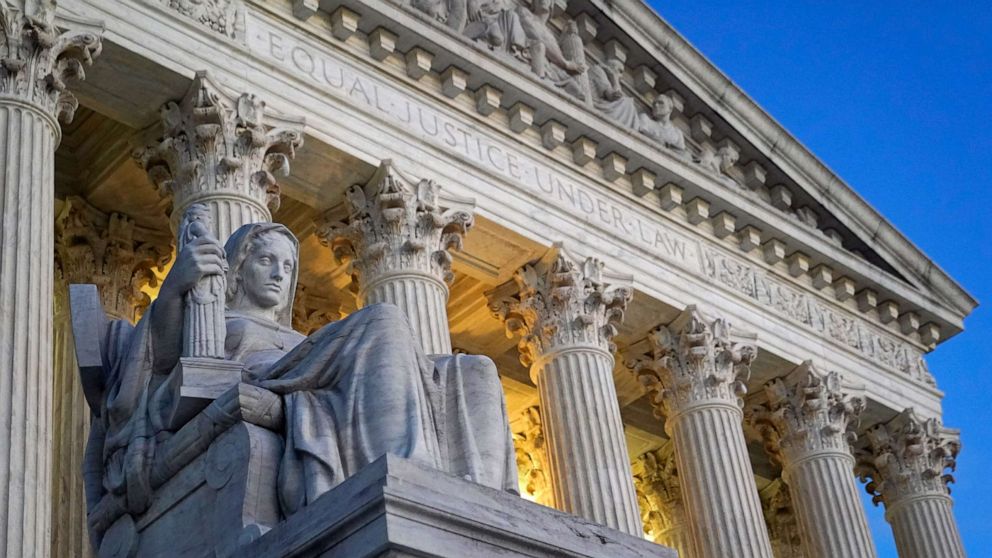之一今年最高法院最大的案件-对美国有重大利害关系选举谁决定人们何时、何地以及如何投票,可能会被抛弃。
不同寻常的是,法官们周四发布了一项命令,要求摩尔诉哈珀案中的双方提交书面解释为什么他们应该继续决定它这表明,鉴于新的州一级的事态发展,他们可能认为此事没有实际意义。
拜登政府支持的北卡罗来纳州共和党和一群投票权倡导者之间的争端,集中在州法院在解决选举争端中的作用。
共和党议员提出了一个边缘法律概念,即“独立的州立法机构理论”,即只有立法者才能制定选举政策,并且在很大程度上不受州法院甚至州长的监督。
民主倡导者说,如果这一理论被采纳,它可能会在全国范围内颠覆州选举法。
北卡罗来纳州最高法院最初裁定保守派议员败诉,保守派议员随后上诉至美国最高法院。法官们在去年年底听取了该案件的口头辩论,并准备在今年春天做出裁决。
但是上个月,新由共和党法官控制的州最高法院同意在3月14日重新审理此案。这在州一级重新引发了诉讼,并可能使美国最高法院在诉讼结束时保持观望。
法官周四的命令要求各方解释,鉴于这一事态发展,他们为何仍拥有管辖权。
“这提出了一个问题,即美国最高法院在摩尔诉哈珀案中的决定是否会变得没有实际意义,”加州大学欧文分校的法学教授兼选举法专家里克·哈森说,写于二月。
回头看看这些论点
在12月的一次听证会上,北卡罗来纳州共和党人进行了长达三个小时的特别紧张的辩论,要求美国最高法院恢复共和党控制的州议会绘制的不公正划分的选举地图,该地图因违反州宪法而被州最高法院驳回。
一个由法院任命的小组绘制了一张新地图,该地图在2022年中期选举中使用。
原告在法官面前辩称,美国宪法的选举条款明确授权州立法机构,而且只有立法机构才能决定联邦选举的“时间、地点和方式”。
代表共和党的律师大卫·汤普森认为:“各州没有权力限制立法机关在行使这一联邦职能时的实质性自由裁量权。”。
北卡罗来纳州的一些选民和亲民主倡导者反对这一举动,认为这违背了美国的历史和传统,并警告说,这将使每个州的数百部选举法无效。
“他们理论的爆炸半径会造成选举混乱,”代表选民的前奥巴马政府副检察长尼尔·卡蒂亚尔律师说。
In a twist, Supreme Court could table major election law dispute -- for now
One ofthe biggest Supreme Court cases of the year-- with major stakes for U.S.elections and who decides when, where and how people vote -- could be thrown out.
In an unusual twist, the justices on Thursday issued an order askingboth sides in Moore v. Harperto submit written explanations onwhy they should continue to decide it, indicating that they may find the matter moot in light of new state-level developments.
The dispute between the North Carolina GOP and a group of voting rights advocates, backed by the Biden administration, centers on the role of state courts in resolving election disputes.
The Republican lawmakers have advanced a fringe legal concept, known as the “independent state legislature theory,” that only legislators can set election policy and can do so largely free from any oversight by state courts or even governors.
Democracy advocates say that if the theory is adopted, it could upend state election laws nationwide.
The North Carolina Supreme Court initially ruled against the conservative lawmakers, who in turn appealed to the nation’s highest court. The justices heard oral arguments in the case late last year and have been poised to issue a ruling this spring.
But last month, the state Supreme Court, newly controlled by Republican justices, agreed to grant a rehearing in the case, on March 14. That rekindled the litigation at a state level and may serve to keep the U.S. Supreme Court on the sidelines while it plays out.

Light illuminates part of the Supreme Court building on Capitol Hill in Washington, Nov. 16, 2022.
Patrick Semansky/AP, FILE
The justices' order on Thursday asks the parties to explain why they still have jurisdiction in light of this development.
"It raises the question whether the U.S. Supreme Court’s decision in Moore v. Harper could become moot," Rick Hasen, a University of California, Irvine, law professor and election law expert,wrote in February.
Looking back at the arguments
In an extraordinary and tense debate stretching three hours during a hearing in December, the North Carolina Republicans asked the U.S. Supreme Court to reinstate a gerrymandered election map drawn by the GOP-controlled state legislature after it was thrown out by the state Supreme Court for violating the state constitution.
A court-appointed panel drew a new map which was used during the 2022 midterm election.
The plaintiffs argued before the justices that the U.S. Constitution's elections clause expressly empowers the state legislature, and legislature alone, to dictate the "time, places and manner" of federal elections.
"States lack the authority to restrict the legislatures' substantive discretion when performing this federal function," argued attorney David Thompson, representing the Republicans.
A group of North Carolina voters and pro-democracy advocates opposed the move as contrary to the nation's history and tradition and warned that it would invalidate hundreds of election laws in every state.
"The blast radius from their theory would sow elections chaos," said attorney Neal Katyal, the former Obama administration solicitor general representing the voters.






